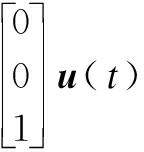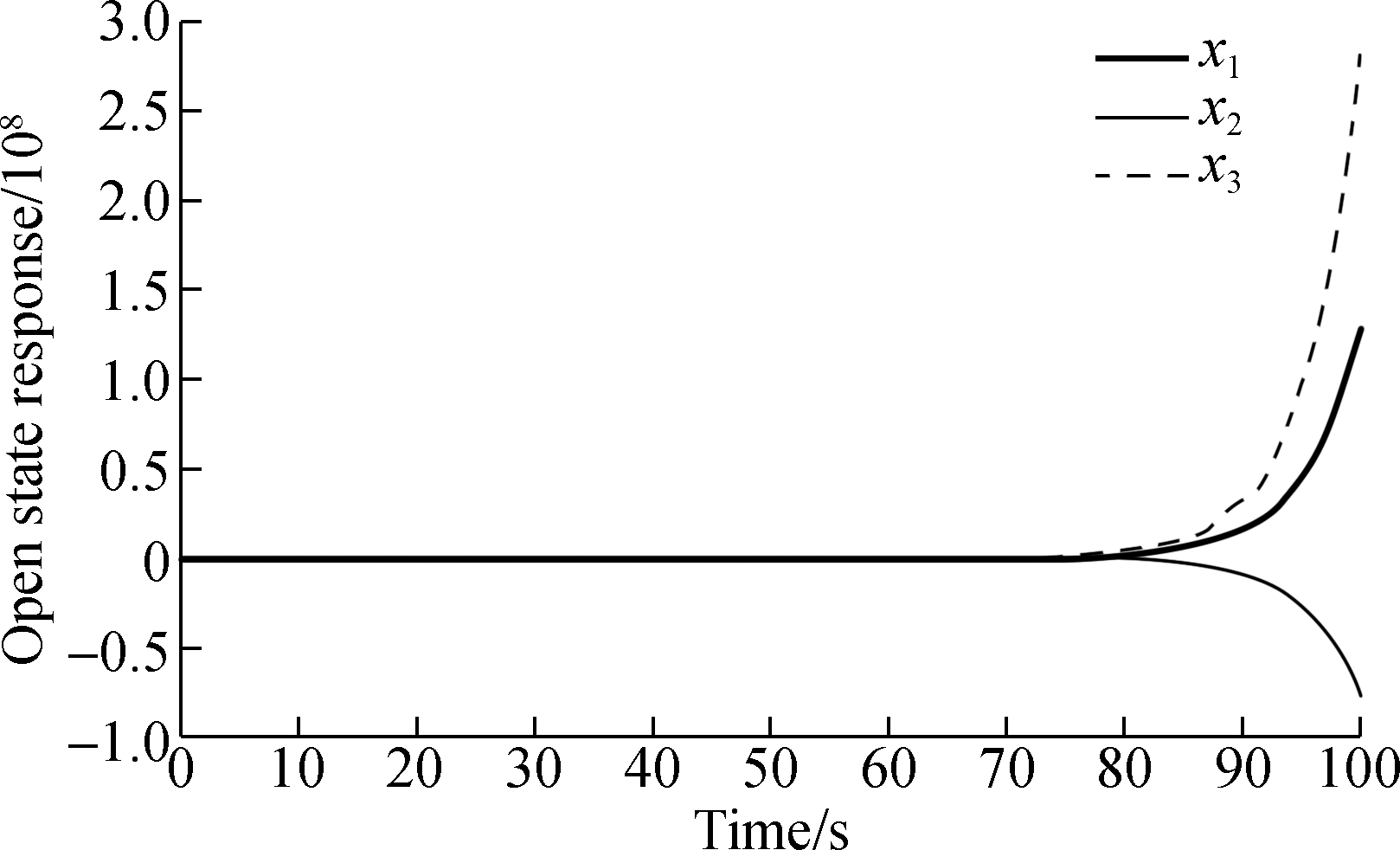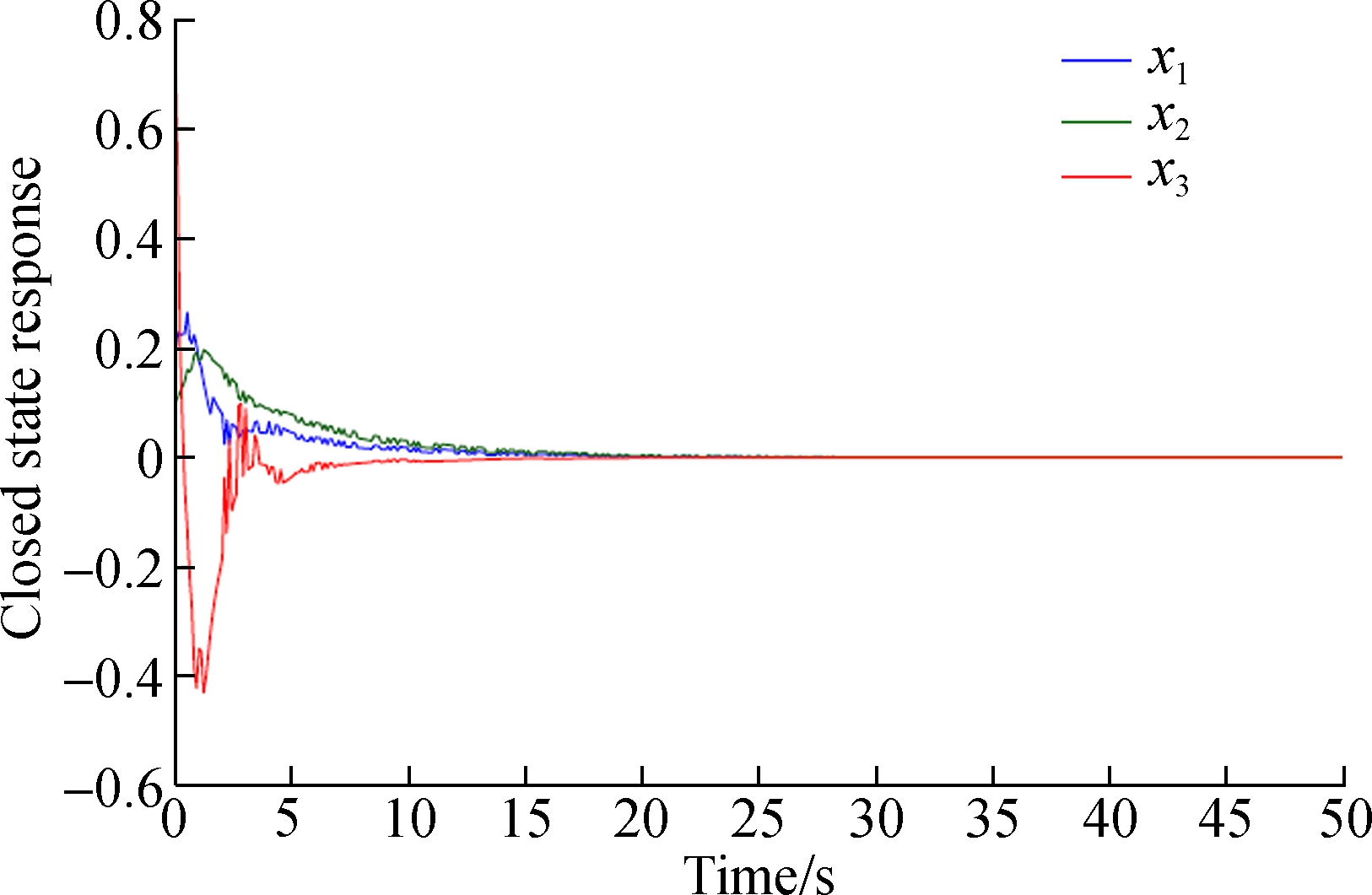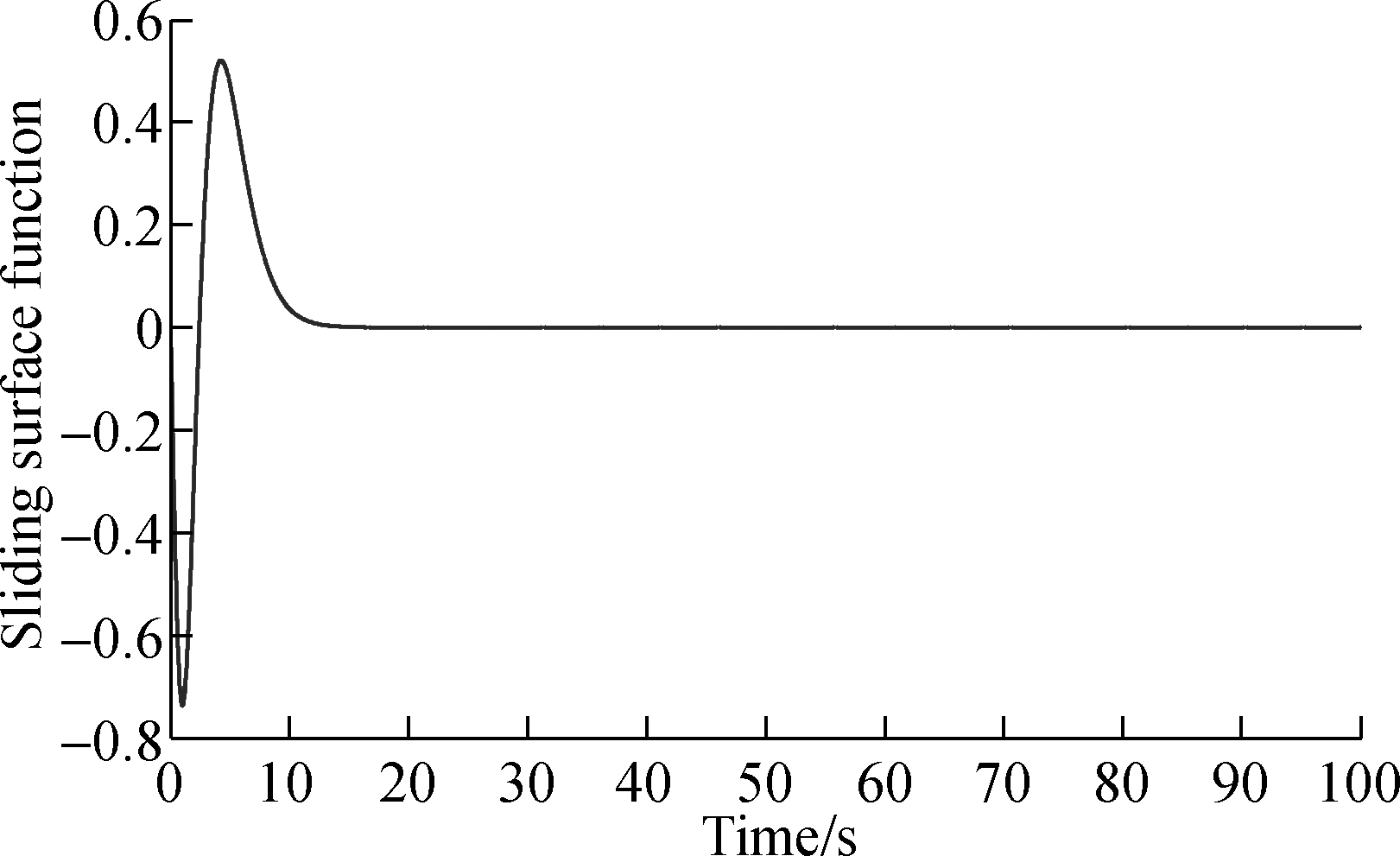Descriptor systems,which are also known as singular systems, implicit systems, semi-state systems, differential algebraic systems, generalized state space systems, have been extensively studied over the past decades due to the fact that they can describe a great many natural phenomena compared to standard state-space systems[1-3]. Zhang et al.[4] explored the stability and stabilization of descriptor systems. More recently, Gao et al.[5] proposed stability criteria for descriptor Markovian jump systems (DMJSs) with fully known transition probabilities. However, variable structure control (VSC) for DMJSs subject to partially unknown transition probabilities (PUTPs) has been seldom investigated thoroughly[6-8].
VSC also refers to sliding mode control (SMC), which is an efficient robust control method to deal with uncertain systems, delay time systems and nonlinear systems. Due to its insensitive features to the variation of system parameters and external disturbance during the sliding phase, it has been extensively applied to a variety of practical engineering systems[9]. Utilizing a discontinuous control to drive the state trajectory to the pre-specified sliding surface and remain there for all subsequent time is the essence of VSC[10]. Over the past few decades, VSC has successfully been applied to problems such as automatic flight control, control of electric motors, chemical processes, helicopter stability augmentation systems, space systems and robots[11]. Recently, VSC has also been investigated in stochastic systems[12-15], time-delay systems[16-18] and MJSs[19-22]. However, only a little literature focuses on the VSC of DMJSs[1,22]. Li et al.[10] investigated the VSC problems for continuous-time DMJSs with a mode dependent derivative term coefficient. As far as we know, VSC for DMJSs subject to PUTPs has not been researched thoroughly. It must be mentioned that the entire information on transition probabilities is known, which is a common hypothesis for simplifying the analysis and synthesis of DMJSs in most of the studies. However, in practice, getting access to available transition probabilities sometimes seems unlikely, and the expenditure is possibly exorbitant or time-consuming. Hence, instead of having great complexity when surveying and estimating all the transition probabilities, it is necessary and important to further investigate more general DMJSs subject to PUTPs.
Motivated by the aforementioned facts, the dynamic sliding mode controller design problem for continuous-time DMJSs with PUTPs is studied. First, a sufficient condition, which guarantees that the DMJSs subject to PUTPS are stochastically admissible, is derived in the light of precise LMIs. Then, we construct a novel and high-performance sliding surface function for DMJSs subject to PUTPS and design an expeditious sliding mode controller to study the pre-specified sliding surface in finite time. The sliding surface function has two parameters which can be adjusted according to actual demand. The sliding mode controller is efficient and agile, which can drive systems’ steady operations. A standard is proposed to ensure the stochastic admissibility of the sliding mode dynamics according to the result of stochastic admissibility. Finally, the effectiveness and practicability of the acquired results are illustrated by a practical example.
1 Problem Formulation and Preliminaries
Fix the probability space (Ω,F,P) and consider the following DMJSs:
![]()
B(rt)[u(t)+F(rt)w(t)]
(1)
where x(t)∈Rn, u(t)∈Rm are the state vector and input vector, respectively. {rt,t≥0} is the continuous-time discrete-state Markovian process taking values in l={1,2,…,N}. ΔA(rt,t)∈Rn×n is the uncertain matrix, and w(t)∈Rl is the disturbance. The switching behavior between different modes is described by the following transition probabilities:
(2)
![]() ∀i,j∈l,i≠j
∀i,j∈l,i≠j
(3)
where h>0, o(h) is infinitesimal such that ![]() and λij≥0 (∀i,j∈l, i≠j) denotes the switching rate from mode i at time t to mode j at time t+h. The set l contains N modes of system (1) and for simplicity, for each possible value rt=i∈l, the system matrices of the i-th mode are denoted by E(rt)=Ei, A(rt)=Ai, ΔA(rt)=ΔAi, B(rt)=Bi. Without loss of generality, the matrix Ei∈Rn×n may be singular, that is rankEi=r≤n. Ai and Bi describe the nominal systems, which are known constant matrices with appropriate dimensions. Matrices Di and Vi are defined as known constant matrices of appropriate dimensions. For the simplification of presentation, the following matrix is given:
and λij≥0 (∀i,j∈l, i≠j) denotes the switching rate from mode i at time t to mode j at time t+h. The set l contains N modes of system (1) and for simplicity, for each possible value rt=i∈l, the system matrices of the i-th mode are denoted by E(rt)=Ei, A(rt)=Ai, ΔA(rt)=ΔAi, B(rt)=Bi. Without loss of generality, the matrix Ei∈Rn×n may be singular, that is rankEi=r≤n. Ai and Bi describe the nominal systems, which are known constant matrices with appropriate dimensions. Matrices Di and Vi are defined as known constant matrices of appropriate dimensions. For the simplification of presentation, the following matrix is given:
ΔAi(t)=DiHi(t)Vi
(4)
Thus, we can rewrite the linear singular system as
(5)
where Di, Vi are the constant matrices and ![]() Thus, we have the presentation of singular system as
Thus, we have the presentation of singular system as
(6)
Furthermore, the transition probabilities of the jumping process in this paper are considered to be partially unavailable, that is, some elements in matrix Λ is unknown. For example, for system (6) with N operation modes, the Markovian process transition probabilities matrix Λ can be defined as

(7)
where * represents the unavailable elements. For convenience, ∀i∈l, l=lik+liuk is denoted as
lik={j:λij is known}, liuk={j:λij is unknown}
(8)
Then, if lik≠∅, it is further depicted as
![]() ∀l≤m≤N
∀l≤m≤N
(9)
where ![]() stands for the m-th known element subject to the index
stands for the m-th known element subject to the index ![]() in the i-th row of matrix Λ. As well, throughout this paper, we denote
in the i-th row of matrix Λ. As well, throughout this paper, we denote ![]() To facilitate the later discussion, two sets are defined as follows:
To facilitate the later discussion, two sets are defined as follows:
Note that ![]() and
and ![]() may be different for each i∈l.
may be different for each i∈l.
Remark 1 The validity of the jumping process {rt,t≥0} in the existing literature is commonly hypothesized to be completely known ![]() ∅,
∅, ![]() or completely unknown
or completely unknown ![]() ∅). Furthermore, the transition probabilities with norm-bounded or polytypic uncertainties require the knowledge of structure or bounds of uncertainties, which can still be viewed as accessible in the sense of this paper. Hence, our transition probabilities matrix considered in the sequel is a more natural assumption for the DMJSs and covers the existing ones.
∅). Furthermore, the transition probabilities with norm-bounded or polytypic uncertainties require the knowledge of structure or bounds of uncertainties, which can still be viewed as accessible in the sense of this paper. Hence, our transition probabilities matrix considered in the sequel is a more natural assumption for the DMJSs and covers the existing ones.
In this paper, our aim is to develop a sufficient condition such that the unforced continuous-time DMJSs (6) with PUTPs (8) is stochastically admissible and to design a sliding mode controller for system (6) with PUTPs (8) such that the resulting closed-loop system is stochastically admissible.
Lemma 1[23] Let X,Y,F be the real matrices of appropriate dimensions with FT(t)F(t)≤I then
XFY+YTFTXT≤XXT+YTY
(10)
Lemma 2(Schur complement[24]) Given constant matrices Ω1,Ω2,Ω3, where ![]() and
and ![]() then
then ![]() if and only if
if and only if
2 Main Results
In this section, the stability will be studied and the sliding mode controller will be designed based on Lemma 1 and the VSC theory, respectively.
2.1 Sliding mode function design
A novel sliding surface function is designed as follows:
(11)
Note that the sliding surface function of our design is a dynamic sliding surface. Bi∈Rm×m, Ei∈Rn×n, x(t)∈Rn, and Gi∈Rm×n can be regarded as an adjustable parameter matrix and βi∈Rn×n is a constant matrix which can be chosen arbitrarily.
Remark 2 Enlightened by the sliding surface function[9], dynamic VSC for the T-S fuzzy system is considered. We design a novel sliding surface function (11) on account of system states and inputs for DMJSs (6) with PUTPs (8). It is worth mentioning that the sliding surface function in Ref.[5] cannot be applied to the DMJSs (6) with PUTPs (8) directly. Hence, referring to Ref.[5], it is necessary to design a novel sliding surface function (11), which is suitable for the DMJSs (6) with PUTPs (8).
While the trajectories reach the sliding surface, we can derive S(t)=0. Then, we can derive the derivation of the sliding surface as follows:
(12)
Substituting Eq.(6) into Eq.(12), we can derive
(13)
Let u(t)=ueq(t), and we can obtain the equivalent control ueq(t) as
(14)
Substituting the equivalent control ueq(t) into Eq.(6), we can obtain the equivalent dynamic system of the original system as
![]()
ΔAi(t)-Eiβi)]x(t)
(15)
Theorem 1 The equivalent dynamic unforced nominal system (15) is stochastically admissible if the following LMI has a solution Pi, which satisfies that ![]() is semi-positive definite.
is semi-positive definite.

(16)
where
Proof The following candidate of the Lyapunov function is chosen to analyze the stability of the equivalent dynamic system (15):
(17)
Then, taking the time derivative along the state trajectory of system (15), we obtain
xT(t){[Ai+ΔAi(t)-Bi(GiBi)-1Gi(Ai+
(18)
By using Lemma 1, the following inequality can be obtained:
(19)
Substituting inequality (19) into Eq.(18), it can be derived that
(20)
By applying Schur complement Lemma 2 to (20), it can be obtained that
(21)
which is equivalent to (16).
Hence, if the LMI has a solution Pi satisfying that ![]() is semi-positive definite, it can be determined that
is semi-positive definite, it can be determined that ![]() This means that not only the equivalent dynamic system (6) is stochastically admissible but also the state trajectories can be constrained to the sliding surface. The proof is completed.
This means that not only the equivalent dynamic system (6) is stochastically admissible but also the state trajectories can be constrained to the sliding surface. The proof is completed.
Remark 3 During the design of the novel nonlinear sliding surface function, the adjustable parameter matrix Gi and adjustable constant matrix βi are introduced into the switching function; furthermore, these two adjustable variables are introduced into the LMI (16). The conservatism of the LMI condition can be decreased due to the existence of these two adjustable variables.
2.2 Dynamic sliding mode controller
The VSC problem for DMJSs (6) with PUTPs (8) will be investigated in this subsection. Next, the dynamic sliding mode controller will be designed, which can make the system state trajectory converge to the predefined sliding surface in finite time and thereafter remain on there.
In what follows, a dynamic sliding mode controller based on the system states and inputs will be designed, which assures the reachability of predefined sliding surface (14) in finite time. Thus, the following result can be obtained.
Theorem 2 Consider the descriptor system in Eq.(6). Hypothesize that the sliding surface function is designed in Theorem 1, and there are definite positive matrices Φi, i∈l and ![]() i∈l, which satisfy the following inequalities
i∈l, which satisfy the following inequalities
Φj-Hi≤0 j∈liuk,j≠i
(22)
Φj-Hi≥0 j∈liuk,j≠i
(23)
and the sliding mode controller is constructed by
βiEix(t)+ρsign(S(t))-
(24)
where ρ is a positive constant which is adjustable, and ζ is a very small constant.
Then, the state trajectories of the DMJSs (6) subject to PUTPs (8) are converged to the sliding surface S(t)=0 in finite time and maintained there for all subsequent time.
Proof Choose the Lyapunov functional candidate as
(25)
Taking the weak infinitesimal generator of V(x(t),i) and considering (13), we have
then
Bi(u(t)+Fiw(t))-Eiβix(t)]}TΦiS(t)+
(26)
Considering (24) and after collating (26), we can obtain
(27)
Since ![]() the following equation holds for arbitrary matrices
the following equation holds for arbitrary matrices ![]()
(28)
By adding the left side of (22) into (21), we obtain
Note that, the set of LMIs (22) and (23) are equivalent to the following inequality:
(29)
Hence, one can acquire
LV(x(t),i)<0
(30)
which yields that the state trajectories converge to the pre-specified sliding surface in finite time. The proof is completed.
3 Simulation and Result Analysis
In this section, we provide a practical example to testify the advancement and superiority of the proposed method.
We consider the DC motor[23], which represents the actuator that is usually encountered in the position control servo-mechanism. As shown in Fig.1, a load is driven by the DC motor. In Ref.[23], the author ignored the influence of the inductance Li, i=1,2,3, while in this example, the inductance will be taken into consideration. The switch composed of three positions is also observed, and we hypothesize that the switches from one position to the other are dominated by a continuous-time Markovian chain {rt,t≥0} with rt∈l={1,2,3} as shown in (2). For each rt=i∈l, Ri and Li are adopted to represent the active resistances and the inductances, where the active resistance can be implemented by a differential amplifier. The voltage of the inductance, current, the voltage of the source and the speed of the shaft at time t are denoted by uL(t), i(t), u(t) and w(t), respectively. According to the electrical and mechanical law, we obtain

(31)
where Kw and Kt are the electromotive force constant and the torque constant; Jm and Jc are the moments of inertia of the motor and load; bm and bc are the damping ratios of the motor and load, respectively;n is the gear ratio, and
(32)

Fig.1 Block diagram of a DC motor
Additionally, let x1(t)=i(t), x2(t)=w(t), and x3(t)=uL(t). System (31) can be rearranged in the following form:


(33)
If we choose Kw=4, Kt=2.5, Jm=1, Jc=8, bm=1.5, bc=2, n=3, R1=5, R2=4, R3=3, L1=2, L2=3, L3=4, then, from (31) and (32), we can obtain Eq.(6) with the following parameters:



Hypothesize that the mismatched uncertainties in system (6) are depicted by
D1=(-0.5 0.5 0)T
V1=(-0.2 0.2 0), H1=sin(t)
D2=(0 0.5 -0.5)T
V2=(-0.2 0.2 0), H2=cos(t)
D3=(-0.5 0 0.5)T
V3=(-0.2 0.2 0), H3=sin(t)
The transition probabilities matrix is given by

Now, solving LMIs (22) and (23) in Theorem 2 to design a sliding mode controller of the form (24) yields
Φ1=2.43, Φ2=1.76, Φ3=2.34
H1=1.38, H2=1.51, H3=1.68
A feasible solution cannot be found by checking the conditions (15) for system (33), and according to Fig.2, system (33) cannot be stochastically admissible. As for the model shown in Fig.1, its performance can be damaged by instability or impulse or even destroyed. Thus, it is necessary to design a controller to guarantee that the resultant closed loop system is stochastically admissible.

(a)

(b)
Fig.2 State responses.
(a) Open loop system;(b) Markov chain
Next, to verify the effectiveness of the proposed results in this paper, a sliding mode controller in the form of (24) will be constructed such that the resultant closed loop system is stochastically admissible. Hypothesize that the initial states x(0)=(0.2 0.1 0.6)T, u(0)=0.1, sign(ST(t)) is replaced by ![]() Fig.2 shows the state response curve of the open loop system, and the simulation results in Ref.[10] is shown in Fig.3. The state response curve of the closed loop system is shown in Fig.4. The dynamics of the sliding surface function is depicted in Fig.5, and the dynamics of the dynamic sliding mode controller is displayed in Fig.6. It can be observed that by applying the dynamic sliding mode controller, the closed loop system is piecewise regular, impulse free and stochastically stable, which effectively improves the performance of the model in Fig.1. Compared with the method proposed in Ref.[10], the four advantages of our method are obtained as follows:
Fig.2 shows the state response curve of the open loop system, and the simulation results in Ref.[10] is shown in Fig.3. The state response curve of the closed loop system is shown in Fig.4. The dynamics of the sliding surface function is depicted in Fig.5, and the dynamics of the dynamic sliding mode controller is displayed in Fig.6. It can be observed that by applying the dynamic sliding mode controller, the closed loop system is piecewise regular, impulse free and stochastically stable, which effectively improves the performance of the model in Fig.1. Compared with the method proposed in Ref.[10], the four advantages of our method are obtained as follows:
1) Considering the convergence speed of the state trajectories, it clearly shows that the speed of convergence by our method is faster than that of the method given in Ref.[10].
2) As for VSC, the chattering effect is an important aspect that needs concern. In the simulation results, we can confirm that compared with the sliding surface[10], the evolution of the sliding surface in this paper shows that the chattering effect is better suppressed.

(a)

(b)
Fig.3 State responses.
(a) Closed loop system;(b) Markov chain

Fig.4 Simulation results of the example by using the method proposed in Ref.[10]

Fig.5 Sliding surface function

Fig.6 Dynamic sliding mode controller
3) From Fig.4, we can see that the fluctuation of the state trajectories seems acute, but from Fig.3, we can see that the state trajectories are smoother than the results in Ref.[10]. This point deserves mentioning in the process of practical application, and the systems may be damaged if the convergence is too steep.
4) From Fig.4, we can see that the overshoots of the state trajectories are large, but from Fig.3, we can see that the overshoots of state trajectories are smaller than the results in Ref.[10].
From the simulation results, it is clear to see that the state trajectories of the resultant closed-loop system are driven onto the desired sliding surface in finite time, which confirms our proposed method. Also, the simulations sufficiently illustrate that our methods are advanced and correct. As is known to all, in the actual engineering system, stability, convergence speed and overshoot must be considered. In this paper, the sliding surface function and controller are improved in the above aspects.
4 Conclusion
This paper investigates the dynamic VSC problems for DMJSs with PUTPs. We propose a sufficient condition according to precise LMIs to ensure the stochastic admissibility of DMJSs with PUTPs and to construct a dynamic sliding mode controller, which can guarantee the reachability of the state trajectories to the pre-specified sliding surface in finite time despite of the uncertainties and disturbances. Finally, a practical example of a DC motor is provided to demonstrate the effectiveness of the acquired results.
In the existing literature, time delay and packet loss in the network control systems are modeled as a process of using time stamp technology, but for the convenience of research, the existing literature is still based on the hypothesis that the transition probability is completely known. Due to the common existence of network in practical engineering, it is a meaningful topic to combine the DMJSs with PUTPs and network control.
[1] Feng Z G, Lam J. Dissipative control and filtering of discrete-time singular systems[J]. International Journal of Systems Science, 2016, 47(11): 2532-2542. DOI:10.1080/00207721.2014.998751.
[2] Zhang Q L, Liu C, Zhang X. T-S fuzzy control for singular biological systems[M]//Complexity, Analysis and Control of Singular Biological Systems. London: Springer, 2012.
[3] Zhao Y, Jiang X S, Zhang W H. Stochastic H control for discrete-time singular systems with state and disturbance dependent noise[J]. Discrete Dynamics in Nature and Society, 2017, 2017: 1-10. DOI:10.1155/2017/4173852.
control for discrete-time singular systems with state and disturbance dependent noise[J]. Discrete Dynamics in Nature and Society, 2017, 2017: 1-10. DOI:10.1155/2017/4173852.
[4] Zhang L X, Boukas E K. Stability and stabilization of Markovian jump linear systems with partly unknown transition probabilities[J]. IFAC Proceedings Volumes, 2008, 41(2): 15493-15498. DOI:10.3182/20080706-5-kr-1001.02620.
[5] Gao Q, Liu L, Feng G, et al. Universal fuzzy integral sliding-mode controllers based on T-S fuzzy models[J]. IEEE Transactions on Fuzzy Systems, 2014, 22(2): 350-362. DOI:10.1109/tfuzz.2013.2254717.
[6] Li J H, Zhang Q L, Yan X G. Stabilization of descriptor Markovian jump systems with partially unknown transition probabilities[J]. International Journal of Systems Science, 2015, 46(2): 218-226. DOI:10.1080/00207721.2013.775394.
[7] Sheng L, Yang H Z. Stabilization control of a class of discrete-time Markov jump singular systems[J]. Control and Decision, 2010, 25(8): 1189-1194. DOI: 10.13195/j.cd. 2010.08.72.shengl.017. (in Chinese)
[8] Chang H, Fang Y W, Lou S T, et al. Stabilization of a class of continuous-time singular Markov jump systems[J]. Control and Decision, 2012, 27(5):641-645,651. DOI:10.13195/j.cd.2012.05.4.changh.021. (in Chinese)
[9] Utkin V I. Control under uncertainty conditions[M]//Sliding Modes in Control and Optimization. Berlin: Springer, 1992: 189-205. DOI:10.1007/978-3-642-84379-2_13.
[10] Li J H, Zhang Q L, Zhai D, et al. Sliding mode control for descriptor Markovian jump systems with mode-dependent derivative-term coefficient[J]. Nonlinear Dynamics, 2015, 82(1/2): 465-480. DOI:10.1007/s11071-015-2168-0.
[11] Lin J , Fei S , Shen J . Delay-dependent filtering for discrete-time singular Markovian jump systems with time-varying delay and partially unknown transition probabilities[J]. Signal Processing, 2011, 91(2):277-289.
[12] Edwards C, Spurgeon S. Sliding mode control: Theory and applications[M]. CRC Press, 1998.
[13] Zohrabi N, Zakeri H, Abolmasoumi A H, et al. An adaptive sliding mode approach for Markovian jump systems with uncertain mode-dependent time-varying delays and partly unknown transition probabilities[J]. International Journal of Dynamics and Control, 2018:1-17. DOI:10.1007/s40435-018-0430-2.
[14] Yang H, Wang Z D, Shu H S, et al. Almost sure H sliding mode control for nonlinear stochastic systems with Markovian switching and time-delays[J]. Neurocomputing, 2016, 175: 392-400. DOI:10.1016/j.neucom.2015.10.071.
sliding mode control for nonlinear stochastic systems with Markovian switching and time-delays[J]. Neurocomputing, 2016, 175: 392-400. DOI:10.1016/j.neucom.2015.10.071.
[15] Khandani K, Majd V J, Tahmasebi M. Integral sliding mode control for robust stabilization of uncertain stochastic time-delay systems driven by fractional Brownian motion[J]. International Journal of Systems Science, 2017, 48(4): 828-837. DOI:10.1080/00207721.2016.1216201.
[16] Li H Y, Shi P, Yao D Y. Adaptive sliding-mode control of Markov jump nonlinear systems with actuator faults[J]. IEEE Transactions on Automatic Control, 2017, 62(4): 1933-1939. DOI:10.1109/tac.2016.2588885.
[17] Boulaabi I, Sellami A, Hmida F B. Robust delay-derivative-dependent sliding mode observer for fault reconstruction: A diesel engine system application[J]. Circuits, Systems, and Signal Processing, 2016, 35(7): 2351-2372. DOI:10.1007/s00034-015-0148-8.
[18] Xie J, Kao Y G, Park J H. H performance for neutral-type Markovian switching systems with general uncertain transition rates via sliding mode control method[J]. Nonlinear Analysis: Hybrid Systems, 2018, 27: 416-436. DOI:10.1016/j.nahs.2017.10.002.
performance for neutral-type Markovian switching systems with general uncertain transition rates via sliding mode control method[J]. Nonlinear Analysis: Hybrid Systems, 2018, 27: 416-436. DOI:10.1016/j.nahs.2017.10.002.
[19] Ma S P, Boukas E K. A singular system approach to robust sliding mode control for uncertain Markov jump systems[J]. Automatica, 2009, 45(11): 2707-2713. DOI:10.1016/j.automatica.2009.07.027.
[20] Yao D Y, Liu M, Lu R Q, et al. Adaptive sliding mode controller design of Markov jump systems with time-varying actuator faults and partly unknown transition probabilities[J]. Nonlinear Analysis: Hybrid Systems, 2018, 28: 105-122. DOI:10.1016/j.nahs.2017.07.007.
[21] Wang Y Y, Xia Y Q, Shen H, et al. SMC design for robust stabilization of nonlinear Markovian jump singular systems[J]. IEEE Transactions on Automatic Control, 2018, 63(1): 219-224. DOI:10.1109/tac.2017.2720970.
[22] Wu L G, Su X J, Shi P. Sliding mode control with bounded L2 gain performance of Markovian jump singular time-delay systems[J]. Automatica, 2012, 48(8): 1929-1933. DOI:10.1016/j.automatica.2012.05.064.
[23] Boukas E K. Control of singular systems with random abrupt changes[M]. Berlin, Heidelberg: Springer, 2008. DOI:10.1007/978-3-540-74345-3.
[24] Yaz E E. Linear matrix inequalities in system and control theory[J]. Proceedings of the IEEE, 1998, 86(12): 2473-2474. DOI:10.1109/jproc.1998.735454.